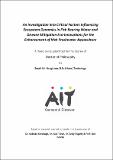| dc.description.abstract | Aims and Rationale: The aquaculture sector is becoming the fastest growing food sector in the world, with an increasing requirement for higher production rates. With the maximum sustainable yield almost exhausted in terms of the global capture fisheries, aquaculture has an important role to help meet the global demand for seafood. The Irish aquaculture industry is worth an estimated €208.4 million, yet stringent limits on water abstraction rates and concerns over pollution of receiving water with aquaculture effluent have hampered intensive sustainability with increasing trends towards recirculation of processed water. Insufficiencies in traditional freshwater aquaculture practices may heighten the potential for growth of harmful finfish pathogens, thus indicating a commensurate need for improved wastewater remediation and disinfection regimes. The aim of this project was to determine the interaction dynamic between biological and physiochemical parameters in freshwater rearing water, to inform for future use as a low cost, natural wastewater remediation process in land-based aquaculture. Studies were also conducted to investigate the development of pulsed ultraviolet (PUV) light as an energy-efficient, eco-friendly disease mitigation technology for land-based aquaculture.
Methods and Results: Phytoplankton are an essential component of the aquatic ecosystem as primary producers, providing the potential for improving culture water quality if monitored and managed correctly. They also act as a natural sustainable food source for fish and other organisms present in culture water. To determine the ecosystem dynamic of rearing water, a study was carried out in a freshwater pill-pond aquaculture farm in the Republic of Ireland, producing Eurasian Perch, Perca fluviatilis, over a 10-month monitoring period. The study involved an investigation of both phytoplankton and bacterial communities (species composition and numbers) in the water and their correlations with selected physiochemical parameters, such as nitrates, nitrites and phosphates. This encompassed a variety of techniques, including molecular methodologies, microscopy, real-time flow cytometry (FCM) and sequencing. Findings showed that both phytoplankton and bacteria numbers peaked in the summer months reaching levels of 1.57 x 105 cells/ml and 9.70 x 106 cells/ml, respectively. Chlorophyta, Bacillariophyta and Cryptophyta were the most dominant phytoplankton divisions observed in the rearing water. Proteobacteria, Cyanobacteria and unclassified bacteria were the most relevant bacterial communities observed through denaturating gradient gel electrophoresis (DGGE) community profiling and sequencing of bands excised from gels. Principle component analysis (PCA) established that temperature, nitrates and bacterial numbers were the parameters that had the strongest correlation with the phytoplankton numbers. PCA analysis also demonstrated a strong relationship between use of sophisticated flow cytometry and in situ AlgaeTorch technologies for determining phytoplankton and cyanobacteria numbers.
In order to advance disinfection processes, the fish pathogens Aeromonas salmonicida and Flavobacterium psychrophilum were subjected to PUV light treatment. Ultraviolet (UV) light prevents DNA replication of microbes due to
iii
alteration of pyrimidine bases of nucleic acids resulting in thymine dimers. The PUV system produces an intense UV flash with high peak power and high current resulting in irreversible DNA alteration and rapid inactivation. This offers an advantage over conventional UV due to a more energy efficient system. The results indicated a decrease in the bacterial load to a non-detectable number. Disinfection via conventional UV light was also investigated as a comparative method for both bacteria and it proved sufficient as a disinfection treatment. The effects of utilizing PUV alongside chemical disinfectants, bronopol and chloramine-T, was also deemed safe, without the production of any toxic by-products.
Conclusions and Significance: Traditional aquaculture produces large amounts of wastewater, threatening its global sustainability. In-depth knowledge of an ecosystem allows for immediate identification of a problem should the dynamic change from the norm, providing a quick resolution time to avoid loss of fish stocks or financial resources. This novel baseline study was conducted as an initial step into the introduction of utilizing natural phytoplankton processes to aid aquaculture practices. Determining baseline biological communities in rearing water, followed by elucidating physicochemical parameters governing wastewater treatment performance, can inform future intensification and diversification of freshwater aquaculture by exploiting and replicating knowledge of favourable algal-microbial ecosystems. Based on preliminary results PUV penetrance is sufficient to kill the pathogens investigated, that are commonly present in processed water used in aquaculture. Overall, PUV light technology offers promising results as a disinfection technology, with the further optimisation required prior to implementation into an in situ setting. | en_US |


